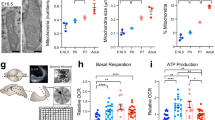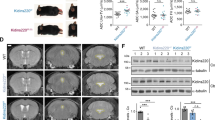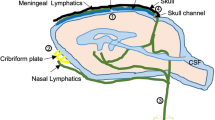Abstract
Of the two isoforms of Liver X receptor (LXR), LXRβ has been shown to have major effects in the central nervous system (CNS) and on the regulation of aquaporins while LXRα has its most marked effects on cholesterol homeostasis. Both receptors have immunomodulatory functions. In LXRαβ knockout (ko) mice, the CNS phenotype is much more severe than in the LXRβ ko mice, suggesting a contribution of LXRα in CNS functions. One of the most striking abnormalities in the brains of LXRαβ ko mice is the occlusion of the lateral ventricles with age. In the present study, we have found by immunohistochemical staining that both LXRα and LXRβ are expressed in the cell nuclei of the epithelium of the choroid plexus and in the ependymal cells surrounding the lateral ventricles. The two receptors regulate several genes and can compensate for each other on expression of genes involved in structural integrity (E-cadherin, P-cadherin and β-catenin) and function (aquaporin 1 and carbonic anhydrase IX). Aquaporin 4 (AQ4) is not expressed in the choroid plexus but is expressed in the astrocytic end feet and ependymal cells. AQP4 expression was increased in white matter around lateral ventricles but not in neurons of LXRαβ ko mice. The data show that LXR is a regulator of cerebrospinal fluid (CSF) both at the choroid plexus and at the astrocytic end feet and defects in the synthesis of cerebrospinal fluid may be targeted by LXR agonists to facilitate CSF production, turnover and clearance in CNS diseases.
This is a preview of subscription content, access via your institution
Access options
Subscribe to this journal
Receive 12 print issues and online access
$259.00 per year
only $21.58 per issue
Buy this article
- Purchase on Springer Link
- Instant access to full article PDF
Prices may be subject to local taxes which are calculated during checkout











Similar content being viewed by others

References
Repa JJ, Li H, Frank-Cannon TC, Valasek MA, Turley SD, Tansey MG et al. Liver X receptor activation enhances cholesterol loss from the brain, decreases neuroinflammation, and increases survival of the NPC1 mouse. J Neurosci 2007; 26: 14470–14480.
Kim HJ, Fan X, Gabbi C, Yakimchuk K, Parini P, Warner M et al. Liver X receptor beta (LXRbeta): a link between beta-sitosterol and amyotrophic lateral sclerosis-Parkinson's dementia. Proc Natl Acad Sci USA 2008; 105: 2094–2099.
Theofilopoulos S, Griffiths WJ, Crick PJ, Yang S, Meljon A, Ogundare M et al. Cholestenoic acids regulate motor neuron survival via liver X receptors. J Clin Invest 2014; 124: 4829–4842.
Wang L, Schuster GU, Hultenby K, Zhang Q, Andersson S, Gustafsson JA . Liver X receptors in the central nervous system: from lipid homeostasis to neuronal degeneration. Proc Natl Acad Sci USA 2002; 99: 13878–13883.
Tan XJ, Dai YB, Wu WF, Warner M, Gustafsson JA . Anxiety in liver X receptor β knockout female mice with loss of glutamic acid decarboxylase in ventromedial prefrontal cortex. Proc Natl Acad Sci USA 2012; 109: 7493–7498.
Xu P, Li D, Tang X, Bao X, Huang J, Tang Y et al. LXR agonists: new potential therapeutic drug for neurodegenerative diseases. Mol Neurobiol 2013; 48: 715–728.
Marwarha G, Rhen T, Schommer T, Ghribi O . The oxysterol 27-hydroxycholesterol regulatesα-synuclein and tyrosine hydroxylase expression levels in human neuroblastoma cells through modulation of liver X receptors and estrogen receptors-relevance to Parkinson's disease. J Neurochem 2011; 119: 1119–1136.
Fitz NF, Castranio EL, Carter AY, Kodali R, Lefterov I, Koldamova R . Improvement of memory deficits and amyloid-β clearance in aged APP23 mice treated with a combination of anti-amyloid-β antibody and LXR agonist. J Alzheimers Dis 2014; 41: 535–549.
Lefterov I, Bookout A, Wang Z, Staufenbiel M, Mangelsdorf D, Koldamova R . Expression profiling in APP23 mouse brain: inhibition of Abeta amyloidosis and inflammation in response to LXR agonist treatment. Mol Neurodegener 2007; 2: 20.
Zelcer N, Khanlou N, Clare R, Jiang Q, Reed-Geaghan EG, Landreth GE et al. Attenuation of neuroinflammation and Alzheimer's disease pathology by liver x receptors. Proc Natl Acad Sci USA 2007; 104: 10601–10606.
Mateos L, Ismail MA, Gil-Bea FJ, Schüle R, Schöls L, Heverin M et al. Side chain-oxidized oxysterols regulate the brain renin-angiotensin system through a liver X receptor- dependent mechanism. J Biol Chem 2011; 286: 25574–25585.
Leoni V, Caccia C . Oxysterols as biomarkers in neurodegenerative diseases. Chem Phys Lipids 2011; 164: 515–524.
Foglio E, Rodella LF . Aquaporins and neurodegenerative diseases. Curr Neuropharmacol 2010; 8: 112–121.
Chen Y, Chen K, Zhang J, Li X, Shu N, Wang J et al. Disrupted functional and structural networks in cognitively normal elderly subjects with the APOE ɛ4 allele. Neuropsychopharmacology 2014; 40: 1181–1191.
Kim J, Yoon H, Basak J, Kim J . Apolipoprotein E in synaptic plasticity and alzheimer's disease: potential cellular and molecular mechanisms. Mol Cells 2014; 37: 767–776.
Javitt NB . Alzheimer's disease: neuroprogesterone, epoxycholesterol, and ABC transporters as determinants of neurodesmosterol tissue levels and its role in amyloid protein processing. J Alzheimers Dis 2013; 35: 441–450.
Fan X, Kim HJ, Bouton D, Warner M, Gustafsson JA . Expression of liver X receptor beta is essential for formation of superficial cortical layers and migration of later-born neurons. Proc Natl Acad Sci USA 2008; 105: 13445–13450.
Dai YB, Tan XJ, Wu WF, Warner M, Gustafsson JA . Liver X receptor βprotects dopaminergic neurons in a mouse model of Parkinson disease. Proc Natl Acad Sci USA 2012; 109: 13112–13117.
Gilardi F, Viviani B, Galmozzi A, Boraso M, Bartesaghi S, Torri A et al. Expression of sterol 27-hydroxylase in glial cells and its regulation by liver X receptor signaling. Neuroscience 2009; 164: 530–540.
Zhang-Gandhi CX, Drew PD . Liver X receptor and retinoid X receptor agonists inhibit inflammatory responses of microglia and astrocytes. J Neuroimmunol 2007; 183: 50–59.
Xu P, Xu H, Tang X, Xu L, Wang Y, Guo L et al. Liver X receptor β is essential for the differentiation of radial glial cells to oligodendrocytes in the dorsal cortex. Mol Psychiatry 2014; 19: 947–957.
Chen J, Zhang X, Kusumo H, Costa LG, Guizzetti M . Cholesterol efflux is differentially regulated in neurons and astrocytes: Implications for brain cholesterol homeostasis. Biochim Biophys Acta 2013; 1831: 263–275.
Papadopoulos MC, Verkman AS . Aquaporin water channels in the nervous system. Nat Rev Neurosci 2013; 14: 265–277.
Boassa D, Yool AJ . Curr Physiological roles of aquaporins in the choroid plexus. Top Dev Biol 2005; 67: 181–206.
Oshio K, Watanabe H, Song Y, Verkman AS, Manley GT . Reduced cerebrospinal fluid production and intracranial pressure in mice lacking choroid plexus water channel Aquaporin-1. FASEB J 2005; 19: 76–78.
Igarashi H, Tsujita M, Kwee IL, Nakada T . Water influx into cerebrospinal fluid is primarily controlled by aquaporin-4, not by aquaporin-1: 17O JJVCPE MRI study in knockout mice. Neuroreport 2014; 25: 39–43.
Saxena S, Caroni P . Selective neuronal vulnerability in neurodegenerative diseases: from stressor thresholds to degeneration. Neuron 2011; 71: 35–48.
Schuster GU, Parini P, Wang L, Alberti S, Steffensen KR, Hansson GK et al. Accumulation of foam cells in liver X receptor-deficient mice. Circulation 2002; 106: 1147–1153.
Alberti S, Schuster G, Parini P, Feltkamp D, Diczfalusy U, Rudling M et al. Hepatic cholesterol metabolism and resistance to dietary cholesterol in LXRbeta-deficient mice. J Clin Invest 2001; 107: 565–573.
Steffensen KR, Robertson K, Gustafsson JA, Andersen CY . Reduced fertility and inability of oocytes to resume meiosis in mice deficient of the LXR genes. Mol Cell Endocrinol 2006; 256: 9–16.
Kim HJ, Andersson LC, Bouton D, Warner M, Gustafsson JA . Stromal growth and epithelial cell proliferation in ventral prostates of liver X receptor knockout mice. Proc Natl Acad Sci USA 2009; 106: 558–563.
Tan XJ, Dai YB, Wu WF, Kim HJ, Barros RP, Richardson TI et al. Reduction of dendritic spines and elevation of GABAergic signaling in the brains of mice treated with an estrogen receptor β ligand. Proc Natl Acad Sci USA 2012; 109: 1708–1712.
Wu WF, Tan XJ, Dai YB, Krishnan V, Warner M, Gustafsson JA . Targeting estrogen receptor β in microglia and T cells to treat experimental autoimmune encephalomyelitis. Proc Natl Acad Sci USA 2013; 110: 3543–3548.
Damkier HH, Praetorius J . Genetic ablation of Slc4a10 alters the expression pattern of transporters involved in solute movement in the mouse choroid plexus. Am J Physiol Cell Physiol 2012; 302: C1452–C1459.
Ren Z, Iliff JJ, Yang L, Yang J, Chen X, Chen MJ et al. 'Hit & Run' model of closed-skull traumatic brain injury (TBI) reveals complex patterns of post-traumatic AQP4 dysregulation. J Cereb Blood Flow Metab 2013; 33: 834–845.
Schubert W, Frank PG, Woodman SE, Hyogo H, Cohen DE, Chow CW et al. Microvascular hyperpermeability in caveolin-1 (−/−) knock-out mice: treatment with a specific nitric- oxide synthase inhibitor, L-name, restores normal microvascular permeability in Cav-1 null mice. J Biol Chem 2002; 277: 40091–40098.
Torres JM, Pumarola M, Ariño J . Central nervous system gene expression changes in a transgenic mouse model for bovine spongiform encephalopathy. Vet Res 2011; 42: 109.
Gabbi C, Kim HJ, Barros R, Korach-Andrè M, Warner M, Gustafsson JA . Estrogen- dependent gallbladder carcinogenesis in LXRbeta-/- female mice. Proc Natl Acad Sci USA 2010; 107: 14763–14768.
Song L, Ge S, Pachter JS . Caveolin-1 regulates expression of junction-associated proteins in brain microvascular endothelial cells. Blood 2007; 109: 1515–1523.
Badaut J . Aquaglyceroporin 9 in brain pathologies. Neuroscience 2010; 168: 1047–1057.
Poca MA, Sahuquillo J . Short-term medical management of hydrocephalus. Expert Opin Pharmacother 2005; 6: 1525–1538.
Supuran CT . Carbonic anhydrases: novel therapeutic applications for inhibitors and activators. Nat Rev Drug Discov 2008; 7: 168–181.
Chow TW, Pollock BG, Milgram NW . Potential cognitive enhancing and disease modification effects of SSRIs for Alzheimer's disease. Neuropsychiatr Dis Treat 2007; 3: 627–636.
Gabbi C, Kong X, Suzuki H, Kim HJ, Gao M, Jia X et al. Central diabetes insipidus associated with impaired renal aquaporin-1 expression in mice lacking liver X receptor β. Proc Natl Acad Sci USA 2012; 109: 3030–3034.
Gabbi C, Kim HJ, Hultenby K, Bouton D, Toresson G, Warner M et al. Pancreatic exocrine insufficiency in LXRbeta-/- mice is associated with a reduction in aquaporin-1 expression. Proc Natl Acad Sci USA 2008; 105: 15052–15057.
Stokum JA, Kurland DB, Gerzanich V, Simard JM . Mechanisms of astrocyte-mediated cerebral edema. Neurochem Res 2015; 40: 317–328.
Thrane AS, Rangroo Thrane V, Nedergaard M . Drowning stars: reassessing the role of astrocytes in brain edema. Trends Neurosci 2014; 37: 620–628.
Acknowledgements
This study was supported by grants from the Emerging Technology Fund of Texas under agreement 300-9-1958, the Robert A Welch Fund (E-0004) and the Swedish Science Council. We thank our colleagues Dr Kaberi Das, Dr Bilqees Bhatti and Christopher A Brooks for mouse work assistance.
Author information
Authors and Affiliations
Corresponding author
Ethics declarations
Competing interests
The authors declare no conflict of interest.
PowerPoint slides
Rights and permissions
About this article
Cite this article
Dai, Yb., Wu, Wf., Huang, B. et al. Liver X receptors regulate cerebrospinal fluid production. Mol Psychiatry 21, 844–856 (2016). https://doi.org/10.1038/mp.2015.133
Received:
Revised:
Accepted:
Published:
Issue Date:
DOI: https://doi.org/10.1038/mp.2015.133


